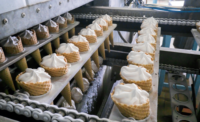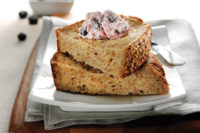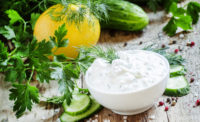In September 2011, a study appeared in the journal Appetite reporting that texture, not flavor, best predicted the level of satiation that subjects expected from certain dairy products. In three separate experiments, the researchers wrote, product samples with the thicker texture — whether yogurt, custard or chocolate milk — rated higher for expected satiation than thinner ones.
This was no surprise to Rudy Wouters, vice president of food application technology and head of the Beneo Technology Center in Antwerp, Belgium. Long a student of texture, he’d seen full-bodied products generate similar responses before.
“If you look at the difference between a fruit juice and a yogurt smoothie,” he said, “you see they’re quite similar in caloric value. But what you notice if you drink the smoothie is that it’s thick, and in the end your stomach feels fuller. You’re more readily satisfied.”
More satisfaction with fewer calories. If that’s what texture can deliver, it could prove a handy tool in an era when high satiety at low caloric cost is both a public health goal and an industry imperative. And in dairy especially — where the only quality consumers value as much as rich, creamy goodness is health and wellness — texture may be the product developer’s ace in the hole.
Few trends have hit the dairy case with greater force than the current health and wellness drive. In dairy formulation terms, that usually manifests as fat and sugar reduction. But the paradox is that the very fat and sugar that are targeted for reduction are also responsible for dairy’s “richness, creaminess, smoothness and softness that have translated directly into enjoyment,” said Ana Maria Garavito, food chemist, Gum Technology Corp. Tucson, Ariz.
It’s a simple matter of food science. Fat particles coat the tongue and palate, altering food properties such as viscosity, density and friction, and consequently influencing the product perception, Garavito said. Sugar, meanwhile, supplies texture-boosting solids, binds free water and dampens freezing points — to say nothing of its contribution to taste.
Dairy consumers tend to be of two minds when choosing between these ideals of sensory appeal and sound nutrition.
“The large majority continues to perceive the richness and creaminess of dairy products as a guarantee of satisfaction,” Garavito noted, “while the other type of consumer opts for lighter, fresh alternative products.” But the common denominator uniting them “is that they’re both looking for cleaner labels and healthier options,” she said.
Starch to mimic fat
How do dairy formulators square that circle? With the help of ingredients that alone or in combination do the textural and functional work of fat and sugar but without the caloric or nutritional impact. Take, for example, specialty starches.
As Jenny Stephens, marketing manager, Penford Ingredients, Centennial, Colo., said, “Specialty starch systems are ideal in providing fat reduction, fiber enrichment, clean labels and cost reduction to varying dairy products, such as yogurts, ice cream and cheese.”
Native rice starches in particular, she noted, are effective fat mimetics. As the starch with the smallest and finest granules, rice starch’s hydrated gel structure yields a uniquely smooth, loose texture that suits it to use in drinkable yogurts and dairy beverages. Even better, said Wouters, its looser texture improves flavor release compared to traditional starches, whose textures act almost as blankets on flavor. And because rice starch’s own taste is so neutral, it doesn’t detract from the delicate profiles of increasingly popular plain and unsweetened yogurts and dairy drinks.
“One of the benefits of rice starch,” Wouters said, “is that you have a number of different varieties all over the world, and these have differing ratios of the two major starch molecules, amylopectin and amylase.”
A waxy starch with more amylopectin might produce a smoother, longer texture, while “regular types,” he said, give a shorter texture. “That allows us to play a bit, depending on what the customer wants.”
Stabilizing with gums
Starches get help in texturizing systems from gums and hydrocolloids, which are go-to ingredients for stabilizing complex dairy matrices, especially ice cream. In traditional formulations, the fat serves to coat and stabilize the surface of the air bubbles whipped into the mix, while sugar, by depressing the freezing point and binding water, reduces ice crystal size and manages moisture migration during freeze-thaw cycling.
Even full-fat and full-sugar ice creams have leaned on gums and hydrocolloids for enhanced stability and texture. But it’s in reduced-fat and reduced-sugar products where they really shoulder the texturizing burden.
As for which ones work best, Garavito credits any of the hydrocolloids in the galactomannan family as “excellent in reducing ice crystal growth.” These include guar, tara and locust bean gums, which she said, “are great for excess water binding and retention over time. And any of these hydrocolloids in combination with citrus fiber and cellulose gum would be the perfect combination to promote aeration, retain moisture and minimize ice crystal formation.”
Use levels are typically very low: between 0.1% and 0.25%, she said. For example, carrageenan can provide creaminess and mimic the fatty sensation on the palate in a reduced-fat soft-serve product at levels as low as 0.005% to 0.01%.
But gums and hydrocolloids can be finicky ingredients in application and sometimes need precise conditions to function properly. Sodium alginates and pectin, for example, “require calcium ions for setting texture, which could require additional time and steps to food processing as well as reformulation,” said Ibrahim Abbas, senior R&D manager at Penford.
This is because alginates form gels when divalent ions like calcium displace sodium and bind the alginate’s polymer chains together — a process that has the advantages of requiring no heat and yielding non-thermo-reversible gels. The drawback is that the gelling occurs instantaneously. Even then, Garavito said, dairy processors can deploy a sequestrant that momentarily retains the calcium ions in the system and releases them slowly.
In any case, the supply of cations needed to get the job done is easy to recruit in calcium-rich dairy. As Garavito notes, the minimum quantity of calcium that low-methoxy pectin requires for gelation is 15 milligrams per gram of pectin.
Get into inulin
Several of the hydrocolloids that texturize low-fat dairy systems also add a touch of fiber. The same can be said for inulin, a fructose-based polysaccharide and soluble prebiotic dietary fiber that’s showing up in growing number of reduced-fat dairy applications.
What makes inulin particularly useful as a fat replacer, Wouters said, is that it requires high shear to function properly.
“From the moment you add inulin to the formulation, when you apply high shear — from homogenization, for example — you create these small inulin particles between 1 and 3 microns,” Wouters said. That’s roughly the size of a post-homogenization fat droplet so the inulin “mimics the effect coming from the fat just by its particle size,” he said.
When using inulin as a texturizer and fat mimetic in yogurt, Wouters recommends formulating with at least 2% for a “significant effect on mouthfeel.” But in something like a low-fat cream cheese, levels rise to 3% to 5% to account for the higher quantity of initial fat and to develop the sturdier texture that products like cream cheese have.
If the goal is both to improve dairy texture and deliver soluble fiber, Wouters advises pegging use levels to “good” and “excellent” fiber-source claims. “There you already have the combination of nutritional and technical benchmarks.”
Restoring sweetness
In addition to its texture- and fiber-boosting benefits, inulin and its short-chain cousin oligofructose help restore the sweetness lacking in reduced-sugar formulations.
“Oligofructose is even sweeter than inulin, and a couple years ago we started seeing a lot of oligofructose used to reduce the sugar in fruit yogurt because it provides body similar to what sugar is providing, and at the same time it provides a certain level of sweetness,” Wouters said.
It won’t provide all the sweetness, of course, which is why even oligofructose-enhanced formulations will need high-intensity sweeteners to pick up sugar’s slack. (An ability to mask those sweeteners’ off notes is another oligofructose benefit.)
But as previously noted, sugar in dairy is about more than just sweet. As Linda Dunning, product manager, systems, DuPont Nutrition & Health, New Century, Kan., said, sugar reduction in dairy reduces the solids and changes the freezing point, both of which affect texture.
“So you have to find a way to adjust the freezing point, and sugar alcohols are used to make those adjustments: lactitol or xylitol. The remainder is done through polydextrose or maltodextrins, as well with modifications from stabilizer and emulsifier systems,” Dunning said.
“The use of zero-calorie, high-intensity sweeteners can replace sweetness, but the loss of sweetener solids can adversely affect texture profile,” said Carol Rainford, food applications scientist, Tate & Lyle Food Systems, Decatur, Ill.
While not strictly speaking a texturant, soluble corn fiber can partially replace those solids and restore texture in reduced-sugar formulations. She said her company has seen particular success using the fiber in Greek-style frozen yogurt.
“And depending on usage level,” she said, “it can deliver the added health benefit of a dietary fiber claim.”
Aiming for a clean label
That ingredients like soluble corn fiber, inulin and native (as opposed to modified) starches fall under the “clean label” umbrella only adds to that positive reception. But the clean-label requirement can become an albatross when building texture into healthful formulations. As Stephens said, “Customers requiring clean label, organic and/or natural-sounding ingredients are selecting from a short list when formulating dairy products.”
“Starches are specifically modified to attach water-loving groups to the starch molecules, imparting more water-holding ability,” Abbas said. “This helps with viscosity, creamy mouthfeel in low- to nonfat dairy products, reduced syneresis and stabilization of any particulates, like the fruit in yogurt.”
It protects the starches against tough conditions, too. Abbas recommends using modified starches over native when extreme processing conditions are expected or there is a need for freeze/thaw stability.
The list of clean-label options that can hack these conditions is growing. And besides, the choice between “native” and “modified” may not be as black-or-white as it appears. Abbas suggests reducing the fat in yogurt and ice cream with a combination of clean-label rice starches, as well as his company’s proprietary modified waxy maize starches and modified potato and tapioca starches.
By bringing together multiple formulation strengths this way, even reduced-fat and reduced-sugar dairy products can boast textures that are the best of all worlds.
Better yogurt through chemistry?
What exactly is Greek-style yogurt? Is it a matter of process? Of formulation? Of ingredient and product origin?
The Food and Drug Administration does not have a standard of identity for Greek yogurt. Consumers, yogurt processors and dairy observers are far less reticent. Their opinions on the subject can be downright strident. Some reject any production methods that stray from the purely physical. Others applaud the use of ingredients and processing aids to achieve the characteristically thicker body and substantial mouthfeel that may be the only qualities all agree define Greek-style yogurt.
“Traditionally, Greek yogurt is a cultured dairy product that has an additional straining step following fermentation,” said Suzanne Mutz-Darwell, senior market development manager, Ingredion Inc., Westchester, Ill.
Straining (by centrifugation, ultrafiltration or old-fashioned gravity) is the physical process that purists insist upon. It removes almost 75% of the water and concentrates the remaining solids. Straining also concentrates the protein in the milk. Greek yogurts on the market vary from 7% to 11% protein, or 10 to 18 grams per serving, Mutz-Darwell said.
The formulation-based approach to making Greek-style yogurt uses gums, starches, proteins and other ingredients to achieve the same textural ends as straining physics. Starches deliver thickness and creaminess, said Ana Maria Garavito, a food chemist at Gum Technology Corp., Tucson, Ariz.
Glanbia Nutritionals, Twin Falls, Idaho, developed a milk protein concentrate that replaces the gelatin and starch used in yogurt manufacture. As part of the company’s proprietary range of MPCs, the ingredients decrease stabilizer use, improve functionality, boost protein content and ensure a cleaner label, said R&D director Loren Ward. Formulated Greek-style yogurts produce less waste, he added. By increasing yields, formulation makes Greek-style yogurt production more cost- and resource effective.
Ingredion’s research found MPC 85 to be the most efficient ingredient to attain the desired protein content, said Mutz-Darwell. Protein hydration prior to its addition to batch tanks will avoid negative and undesirable off tastes. “This can be done by heating and stirring in a surge tank or by allowing the protein powders to soak overnight,” she said.
Too much NFDM can produce an overly sweet yogurt as well as a high solids content. Further, blending liquid condensed skim milk into Greek-style formulations while reducing MPC levels “can help attain the desired protein content while optimizing the overall taste profile,” Mutz-Darwell said.
An Ingredion study of strained yogurts found them to be prone to cracking and breaking and “very adhesive” on the palate with a chalky residue after swallowing, Mutz-Darwell said. By contrast, yogurts made using ingredient technology were shiny, smoother, softer, more slippery and less liable to cracking. They also had higher jiggle and spoon indentation and melted quickly.
All of this gets the inner purist wondering: Is this cheating? If it makes the finished yogurt better than expectations, who cares?



